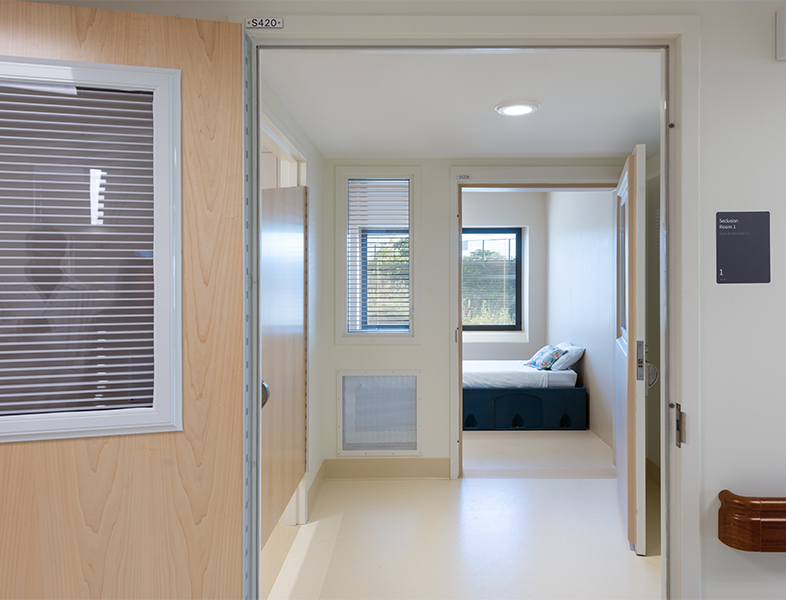There has been rising concern over the past several decades on the effects of noise on health-care outcomes. Study after study has shown that excessive noise levels (which Johns Hopkins Hospital says have risen steadily in hospital settings since the 1960s) negatively affect both caregivers and patients in several ways including elevated stress levels, less effective communication, poor sleep quality, and even potential medical errors.
But although most architects and specifiers are now aware of the acoustical considerations required for effective health-care facility design, less time has been devoted to the acoustical requirements of mental and behavioral health facilities.
These facilities require even more specialized considerations, according to experts – partially because building materials specified for these projects must also be balanced with patient and staff safety, visibility, efficiency, and cost-effective design. Indeed, according to the Canadian Acoustical Association (CAA), mental and behavioral health facility designers must also take into account a range of factors not typically seen in mainstream health-care design. “The patient population is typically very vulnerable, with a low tolerance to stressors,” says a 2019 CAA study prepared by acoustical engineering consultants BKL.
“Depression, anxiety, behavioral or personality disorders as well as abusive or chaotic tendencies factor into their healthcare requirements,” says the study. “In some cases, noise or even particular sounds may play some role or act as a trigger to some symptoms.” The study also notes that while excessive noise can contribute to patient agitation and other issues, excessive quiet can also be problematic in the form of feelings of loneliness or isolation.
All these and other considerations illustrate the unique challenges and opportunities faced by designers of mental and behavioral health facilities. We’ll examine some of these challenges and opportunities below.
Patient and staff safety
Noise is a major consideration when planning around patient and staff safety in a mental and behavioral health facility. Patient suicide is a huge risk, but there are other major safety issues such as falls, escapes (known as “elopements”), and aggression towards other patients or staff. Good design and the right materials, however, can help lower agitation levels and prevent outbursts. A 2013 study by Chalmers University of Technology and Gothenburg University drew a link between hospital design and patient aggression, indicating that facilities designed to mitigate potential noise and crowds can decrease the chances of violent incidents occurring. Designers and specifiers must also be sure to use suicide-resistant materials such as shatterproof glass and ligature-resistant devices – according to one study, the latter is the most “important environmental contributor to suicide resistance.”
Visibility & patient privacy
To improve patient safety and encourage the best possible health outcomes, facility designers must also provide patients with privacy and noise reduction without removing the visibility nurses and doctors need to properly care for them. Good sightlines along corridors and common areas and the avoidance of isolated areas through open, well-designed floor plans are key – staff must always have good visibility and sightlines into patient areas, even when patients believe they have privacy. Patients also need access to natural daylight and (ideally) the outdoors through open design and the use of windows that also act as noise barriers.
Front-line staff considerations
Front-line medical staff are crucial to providing proper care in behavioral and mental health facilities. According to a Shepley-Bulfinch/Cornell University joint survey of behavioral health professionals, good noise control was the second-most important environmental category among those surveyed (adequate safety was No. 1). At the same time, noise control was also determined to be the least effective environmental feature in the respondents’ facilities – indicating that many facilities need to do more to meet expectations of staff (and the needs of patients).
Improved health outcomes
Perhaps the key element in the importance of noise reduction is that it improves health-care outcomes. Brown et al. (2015) concluded in the International Journal of Nursing Studies that “Excess unwanted noise can clearly be detrimental to health and impede recovery,” and that “it is important to begin thinking about the social functions of sound in the mental health environment.” In mental and behavioral health facilities, this is often much more than a nice-to have: Secure rooms, de-escalation spaces, and consultation rooms all require control of reverberant sound to enable better patient privacy and tranquility.
Integrated louvers for better acoustical design
Unicel Architectural’s Vision Control® advanced louvered glazing technology helps mental and behavioral health facility designers meet these challenges and opportunities. These hermetically sealed glass units combine louvers within glass that can be customized to virtually any shape for interior and exterior glazing applications, and include ligature-resistant operators and impact-resistant glass for the utmost in patient and staff safety. They’re specifically designed to provide unprecedented control of vision, light, temperature and sound, including the following sound control features:
- Their 2 1/2″ (63.5mm) dehydrated airspace reduces noise considerably, providing sound attenuation superior to insulating glass units with standard airspaces
- Their ligature-resistant controls operate quietly, smoothly and ensure easy function
- When closed, louvers help attenuate sound when silence or noise reduction is required through sound-absorbing louvered glazing panels
- Vision Control can easily be used in interior window or door applications for patient rooms, providing private rooms for patients with minimal unwanted noise and that are also easily monitored by staff
As we’ve seen, architects and designers working on mental and behavioral health projects must weigh several considerations when specifying materials, including patient and staff safety, visibility, patient privacy, and good acoustical design. Building materials specified for these facilities must ideally address all of these challenges, while also considering efficiency, cost-effectiveness, and aesthetic appeal.
Want to learn more about how Vision Control integrated louvers help meet these and other challenges head-on in mental and behavioral health facility design? Contact us today to learn more.
News and Updates
The latest from Unicel Architectural

The Impact of Building Information Modeling (BIM) Technology in Construction
- Blog, Innovation
Vision Control® For Laser Radiation Safety in Healthcare
- Blog, Product Spotlight


